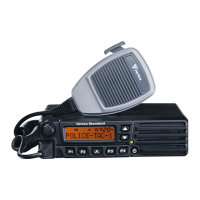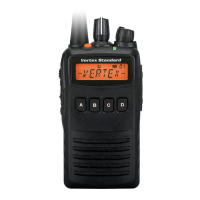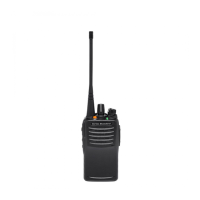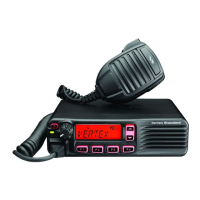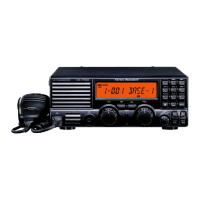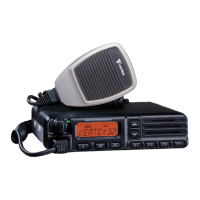7
Circuit Description
Receive Signal Path
Incoming RF from the antenna jack is delivered to the
MAIN-2 Unit and passes through a low-pass filter con-
sisting of coils L2002, and L2003, capacitors C2001,
C2002, C2021, C2023, C2024, C2025, C2026, and C2027,
and antenna switching diode D2004 (RLS135).
Signals within the frequency range of the transceiver
enter a varactor-tuned band-pass filter consisting of coils
L2012 and L2015, capacitors C2058, C2059, C2085,
C2118, and C2119, and diodes D2007, D2008, D2009,
and D2010 (all HVD358B), then are amplified by Q2019
(2SC5006) and enter a varactor-tuned band-pass filter
consisting of coils L2020, and L2025, capacitors C2122,
C2150, C2153, C2154, C2156, C2180, and C2181, and
diodes D2012, D2013, and D2016, D2018, D2026 (all
HVD358B), before application to the first mixer, Q2029
(3SK320).
Buffered output from the VCO is amplified by Q2026
(2SC5005) to provide a pure first local signal between
196.85 and 224.85 MHz for injection to the first mixer
Q1029. The 50.85 MHz first mixer product then passes
through monolithic crystal filter XF2001 (MFT50.85P2,
5.5 kHz BW) to strip away unwanted mixer products, and
is then amplified by Q2041 (2SC4215Y).
The amplified first IF signal is applied to FM IF sub-
system IC Q2048 (TA31136FN), which contains the sec-
ond mixer, second local oscillator, limited amplifier, noise
amplifier, and RSSI amplifier.
The second local signal is produced from the PLL ref-
erence/second local oscillator of X2002 (TCXO
TTS05VS-M1 16.80 MHz). The 16.80 MHz reference
signal is tripled by Q2048, capacitor C2251, and coil
L2022, and the resulting the 50.4 MHz second local sig-
nal is then delivered to the mixer section of Q2048 which
produces the 450 kHz second IF when mixed with the
first IF signal.
The second IF then passes through the ceramic filter
CF2001 (ELFC450G on “Narrow” channels) or CF2002
(ELFY450E on “Wide” and “Narrow” channels) to strip
away all but the desired signal, and is then applied to the
limiter amplifier in Q2048, which removes amplitude
variations in the 450 kHz IF, before detection of the speech
by the ceramic discriminator CD2001 (ECDA450C24).
Squelch Control
The squelch circuitry consists of a noise amplifier,
band-pass filter, and noise detector within Q2048
(TA31136FN).
When no carrier is received, noise at the output of the
detector stage in Q2048 is amplified and band-pass fil-
tered by the noise amplifier section of Q2048 and the net-
work between pins 7 and 8, and then is rectified by detec-
tion circuit in Q2048.
The resulting DC squelch control voltage is passed to
pin 19 of the microprocessor Q2047 (LC87F74C8A). If
no carrier is received, this signal causes pin 19 of Q2047
to go high and pin 30 to go low. Pin 35 signals Q2006
(2SC4154E) to disable the supply voltage to the audio
amplifier Q2005, while pin 30 holds the green (Busy) half
of the LED off, when pin 35 is high and pin 30 is low.
Thus, the microprocessor blocks output from the au-
dio amplifier, and silences the receiver, while no signal is
being received (and during transmission, as well).
When a carrier appears at the discriminator, noise is
removed from the output, causing pin 19 of Q2047 to go
low and the microprocessor to activate the “Busy” LED
via Q2047.
The microprocessor then checks for CTCSS or CDCSS
code squelch information, if enabled. If not transmitting
and CTCSS or CDCSS is not activated, or if the received
tone or code matches that programmed, audio is allowed
to pass through the audio amplifier Q2005 (NJM2070M)
to the loudspeaker by the enabling of the supply voltage
to it via Q2007 (CPH6102).
Transmit Signal Path
Speech input from the microphone MC2001 passes
through the audio amplifier Q2021 (AK2342B) to Q2015
(M62364FP) which adjusts the microphone gain. The ad-
justed audio is applied to the compander Q2010
(LA8630M) which compresses the speech signal accord-
ing to a control command from the microprocessor Q2047
(LC87F74C8A).
The compressed speech signal passes through the
dummy unit and pre-emphasis circuit to Q2021, which
contains the low-pass filter, Voice Scrambler selector, and
high-pass filter.
The output from Q2021 is applied to the AF mute gate
Q2055 (2SK3541), then returns to Q2021, which con-
tains the limiter amplifier, splatter filter and audio amplifier.
The filtered audio signal is applied to Q2015
(M62364FP) which is adjusts the audio level, then is ap-
plied to varactor diode D2017 (HVD350B), which fre-
quency modulates the VCO Q2033 (2SC5226). A por-
tion of the audio signal from Q2015 is applied to TCXO
X2002 (TTS05VS).
The processed audio may then be mixed with a CTCSS
tone generated by Q2047 (LC87F74C8A) for frequency
modulation of the PLL carrier (up to ±5 kHz from the
unmodulated carrier) at the transmitting frequency.
If a CDCSS code is enabled for transmission, the code
is generated by microprocessor Q2047 and delivered to
X2002 (TCXO TTS05VS) for CDCSS modulating.
The modulated signal from the VCO Q2033
(2SC5226) is buffered by Q2026 (2SC5005). The low-
level transmit signal then passes through the T/R switch-
ing diode D2046 (HSC277TRF) to the pre driver ampli-
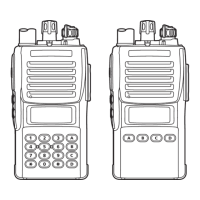
